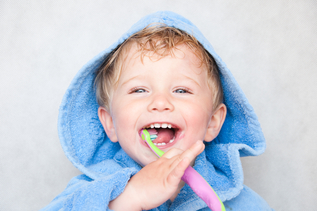 If you have no idea on how to care your toddler’s teeth, then you are not alone. Teaching kids tooth brush for the first time can be intimidating for many parents. But, this should have to be if you and your little toddler follow these tooth brushing tips to help you child’s pearls healthy and strong. Aside from using popular character songs like Elmo’s brushing teeth song, there are other ways you can do to inspire your kids to proper oral care practices. Introducing Oral Hygiene
Parents must begin getting a head start to proper oral care regimen before the child’s first tooth eruption. You can start the process by cleaning the baby’s gums and teeth that are erupting with a wet soft cloth or gauze immediately after a meal. In this way, you will help your baby get used to regular teeth cleaning efforts. Also, any food particles clinging to your child’s erupting teeth and gums will be removed. Introduce Your Toddler to a Toothbrush A child must be introduced to a toothbrush between the age of 12 and 18 months. You will have to use to soft-bristled toothbrush that is made for toddlers. Do not add toothpaste yet. Make this process as enjoyable as possible for your little child. Buy a toothbrush with popular character when demonstrating proper tooth brushing so your toddler can relate. Many parents love to play the video a Sesame Street’s Elmo brushing his teeth for their kids using a smartphone while the child is tooth brushing. Including Toothpaste to Your Toddler’s Oral Care When your toddler turned three years old, you can start adding a tiny amount of toothpaste. Make sure it’s fluoride free toothpaste. A pea-sized amount of toothpaste is already enough and appropriate. You have to make sure that your child knows that it’s necessary to spit it out rather than swallowing it. Giving the toddler a small amount of water for brushing and teaching him how to swish the water to rinse his mouth will encourage your child to spit any toothpaste left. Strive for Quality Brushing Time The American Dental Association suggests that you have to spend at least two minutes when tooth brushing your toddler. But this might not be practical in reality. The American Academy of Pediatric Dentistry recommends that you emphasize more on covering all tooth surfaces, particularly the back teeth. You may be spending more than two minutes brushing their teeth, but ensure every tooth is cleaned during the time you are spending two minutes brushing their teeth. Allow Your Toddler to Brush on Their Own When your child reaches four, your child must start brushing his teeth with supervision. Watch them closely during the process. You may still have to help to reach back teeth. Most dentists agree that kids must be monitored until they reach the age of 8 or 9 because sometimes, they are in too much of a hurry to play or do their activities that they may not be properly brushing their teeth.  Also called as pedodontics, pediatric dentistry is a specialty branch of dentistry that specializes in treating young people. Known as pedodontists, pediatric dentists are highly specialized in the field since they have to complete the necessary additional education to render primary and specialized care to infants, young children and adolescents. Based on the American Academy of Pediatric Dentistry, one must complete at least two additional years of study and in many cases, three years of training in order to become a practicing pediatric dentist. According to the studies from Henry J. Kaiser Family Foundation, there are only about 7,000 pediatric dentists in the US. What is the Difference Between a General Dentist and a Pediatric Dentist? After completing studies from an accredited school and obtaining a license in his/her state of practice, the general dentist is permitted to treat patients of any age. But, like in general medicine, there are several conditions that needs the expertise of a paediatrician. Pediatric dentists are under a distinct set of standards that are defined by the Commission on Dental Accreditation to deal with the unique needs of children and teens such as dental sealants and fluoride treatments. Below are some of the specialized tasks of pediatric dentists:
A pediatric dentist’s office are often adorned with engaging murals and brightly colored wall paint. Kids magazines, toys and games are in the waiting area, which can help towards easing apprehension and uncertainty. Pediatric dentists strive hard to ensure kid’s smiles are bright and healthy. When a child’s dental visit is a positive experience, they may be open and willing to go back for their check-ups.  While eating too much sweets can cause caries and cavities, did you know that lots of other foods can actually strengthen your little one’s teeth? Here is a list of the top foods that help oral health. Oranges, Limes, Kiwis, Berries. Your child’s mouth is full of various types of bacteria and some of them may even cause gum disease such as gingivitis. Vitamin C in fruits such as cantaloupe, orange, limes, strawberries and papaya helps fight bacteria and promote the production of collagens in the gums. Other natural sources of Vitamin C are vegetables such as tomatoes, sweet potatoes and red, orange and yellow peppers. But dentists advise that children must wait at least 30 minutes after eating citrusy foods before cleaning their teeth. It is due to the citric acid present in fruits which can temporarily weaken the enamel. This can leave the teeth susceptible to erosion due to brushing. Seeds and nuts. Sesame, pumpkin and sunflower seeds, and nuts are rich in natural fats that help shield the teeth from bacteria by coating the teeth with its oil. The seed oils help strengthen the enamel too, making teeth more resilient to cavities. In addition, most seeds are packed with calcium too. Children ages 4 and above can eat trail mix as a healthy snack. Sugarless gum. Chewing any food triggers the production of saliva. Saliva loosens plaque, keeps the gums hydrated and stimulates natural antibodies in the mouth. According to the American Dental Association, chewing sugarless gum for 20 minutes after a meal can help prevent decay. In fact, the organization recently awarded Extra, Orbit and Eclipse gums their Seal of Acceptance after Wrigley did studies showing its brand’s dental health benefits. But kids below the age 4 shouldn’t chew gum, unless you can trust them never to swallow it. Dairy products. Starchy carbohydrates such as white potatoes, paste and bread are metabolised into sugar. Such form of sugar feeds certain bacteria in your kid’s mouth, producing acid that causes caries. When kids drink milk or eats cheese or yogurt, foods that rich in Vitamin D, calcium and phosphorus, it increases the pH level of their mouth, which lowers the acid levels as well as the risk for developing tooth caries. Calcium is also great in other ways. Calcium bonds with plaque and to the teeth, which further protects the teeth from lingering acid. It also strengths the bones that support your child’s teeth and repairs damaged enamel, making their teeth more resistant to any periodontal diseases in the future. Crisp vegetables. Celery, green beans, snap peas, cauliflower and raw carrots are ‘chewing foods’, which means it can mechanically clean your child’s gums and teeth. These foods scrape away plaque that children miss when brushing or that accumulates between meals. Tell your children to chew their food and eat slowly.  Keeping your child’s teeth and gums healthy is a year-round job. Yet during winter, dental health and safety for kids signifies having the right balance between the necessary things for mouth care and the fun of a snowy weather. Hot treats, drier air, winter activities and more can put your teeth at risk for damage. Below are some ways to maintain your kids’ teeth and gums health and happy throughout the winter season. Protect their Teeth If your child loves to do winter sports or enjoy the ski slopes, it is necessary to wear some protection from injuries. Physical damage during sports contribute to 10 to 39 percent of dental injuries in children, based on the American Academy of Pediatric Dentistry. Having your kids’ wear face mask or mouthguard when playing winter sport will lessen the risk of dental injury. There are mouthguard available in the drugstore or have your child meet a dentist for custom fitting. Keep Your Child Hydrated If your child spends more time playing a winter sport, they put their health at risk of becoming dehydrated. Kids are more susceptible to dehydration than adults since they weight loss and often times, they are not as able to distinguish thirst. He might also be dehydrated if he’s suffering a terrible flu or cold. To ensure your child’s health and safety, it is best to drink lots of water during winter. If possible, have him drink fluoridated water as it can help protect their teeth from cavities and decay. Watch Out for Sugary Drinks When your child is suffering from sore throat or cough, it is not surprising to use cough drop for relief. Many kids drink juice to battle a cold or have a cup of hot cocoa after doing winter play. But cough drops, hot cocoa and fruit juice can have a bad effect on your child’s teeth since they tend to contain plenty of sugar, leading to decay and cavities. To avoid consumption of too much sugar, give your child sugar-free cough drops. Water will always be the best substitute for juice when you are sick. As for the hot cocoa, try using dark chocolate and real milk, as these contains less sugar. Encourage Proper Dental Habits To protect your kid’s dental health in the winter, it is important to keep proper dental habits. Brush two times a day and floss once a day even when your child has cold or flu. His immune system needs all the help it can have to fight cold or flu virus. To encourage your little ones who are sick to brush their teeth, try using a flavoured toothpaste that comes with satisfying flavors like watermelon and strawberry. When it comes to protecting your child’s health during winter, it’s more than just ensuring they stay warm and free from flu. It also means keeping an eye on your child’s dental health and doing some measures to protect their teeth and gums. |
AuthorMint Kids Dentistry Archives
July 2021
Categories |
Location |
|
Sitemap
|
Forms
|

 RSS Feed
RSS Feed